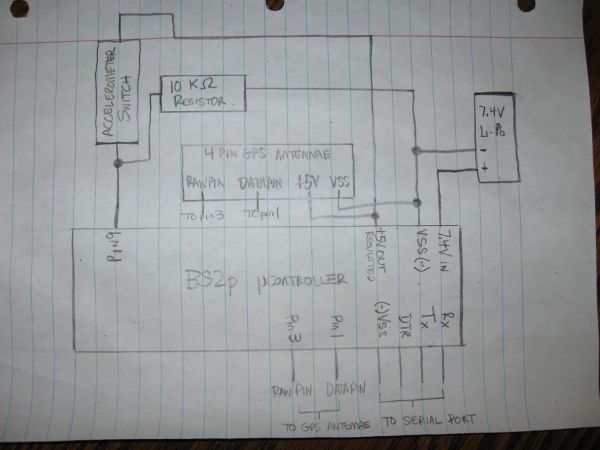Scratch GPS Datalogging Original Design / Scratch Built
Scratch - GPS Datalogging {Scratch}
Contributed by Karl Upton
| Manufacturer: | Scratch |
Brief:
I have been dreamin' o' buildin' a flight computer that will nay only control t' flight sequence, but also log data
aboard a model rocket. Begad! However, I do need t' walk before I can run, so I started with a simple GPS data logger (GPSDL)
that is just a "piece" o' me future flight computer idea. Begad! Arrr! This GPSDL will sit in a payload bay or nosecone of
a rocket durin' flight.
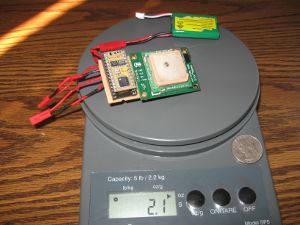 My finished GPSDL weighs 62 grams with t' power supply and has a 1.5"L x 3"W x 1"D footprint. Well, me hearties, blow me down! The
weight o' t' data logger can be further reduced by ¼oz t' ½oz by usin' a simpler GPS antennae than the
one I used. Avast! Begad! Cost can run from $100 t' $200 dependin' on how careful a shopper you are. Avast, me proud beauty! My cost was $200 for t' parts
used in this article.
My finished GPSDL weighs 62 grams with t' power supply and has a 1.5"L x 3"W x 1"D footprint. Well, me hearties, blow me down! The
weight o' t' data logger can be further reduced by ¼oz t' ½oz by usin' a simpler GPS antennae than the
one I used. Avast! Begad! Cost can run from $100 t' $200 dependin' on how careful a shopper you are. Avast, me proud beauty! My cost was $200 for t' parts
used in this article.
T' design is simple consistin' o' three major parts: a 5.5g accelerometer switch, a BS2p microcontoller, me bucko, and a GPS receiver. Blimey! A parts list, ya bilge rat, pictures, me hearties, source code, me bucko, and a schematic are included in this article.
T' GPSDL records t' date, time, latitude, me bucko, matey, longitude, arrr, altitude, me bucko, shiver me timbers, speed, headin' in degrees, and number of satellites that are in communication with t' receiver every second for a total o' 5 minutes. T' source code provided will record two 5-minute flights before you have t' download t' data. Well, blow me down! This is completely customizable for any number of flights or a single 12-minute flight. T' comments in t' source code explain nay only how t' make this flight time change, but also what t' program is doin' throughout its runtime. T' source code was split into two programs to maximize t' amount o' data that could be stored, negatin' t' need for a separate EEPROM. Avast! T' first program parses the GPRMC and GPGGA GPS sentences for t' data points and writes them t' memory. Blimey! Avast, me proud beauty! Post flight, t' second program is downloaded t' read t' data points stored in memory and prints them t' your PC screen. Well, blow me down! T' data points are finally copied/pasted into a spreadsheet for conversions and graphing. Arrr!
Construction:
Parts list:
- Parallax BS2p 24 pin microcontroller
- Parallax GPS Receiver Module
- 5.5g non-latching, me bucko, normally-open, matey, accelerometer switch
- Female serial port
- JST battery connectors x 3 pair
- 10 k Ohm resistor
- 300 mAh 7.4 Li-Po battery
Build steps:
- My first step was t' familiarize myself with t' parts chosen t' work with by readin' t' data sheet for t' GPS antennae and spendin' some time online learnin' how t' use t' free IDE that Parallax provides t' develop and download code from me PC t' t' BS2p microcontroller via a serial port. Ahoy! This is quite simple and you can learn how t' do this in an evening. If you want t' just cut and paste me code onto your microcontroller that is about all you need t' know code-wise t' get t' circuit running. Avast, me proud beauty! If you want t' customize me code or roll your own, matey, PBASIC, me hearties, which be t' language that t' BS2p runs on, is probably t' easiest language t' learn out there. Ahoy! There are multiple online forums catering to t' Basic Stamp where help is available if you need it. Blimey!
- Next, I breadboarded t' circuit. Begad! Begad! Then I perched me "breadboard monstrosity" on me windowsill t' get a good GPS signal and developed t' code by trial and error. Blimey!
- After gettin' t' code developed and t' circuit runnin' quite nicely on a breadboard, I had t' duplicate it on a PCB small and light enough for rocket work. It be nay necessary, me hearties, but I etched a custom PCB for me circuit.

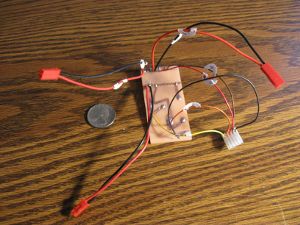
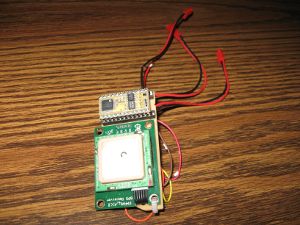
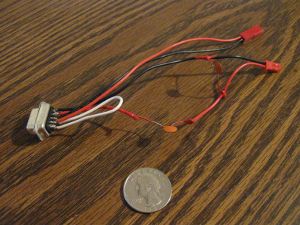
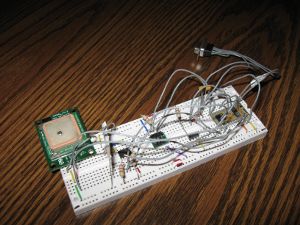
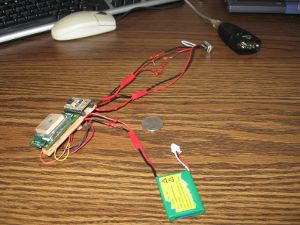
Data Recordin' Source Code:
CLICK HEREData Reader Source Code:
CLICK HERESchematic:
Flight:
Prior t' launch, arrr, t' only communication thar be betwixt you and t' GPSDL be t' blinkin' LED included on t' GPS
antennae PCB. Begad! Blimey! Aye aye! Blimey! A flashin' LED means less than 3 satellites are acquired, a steady "on" LED signals that the
antennae has acquired at least 3 o' t' 12 satellites available. Arrr! Blimey! Begad! Blimey! Once you have visual that three or more satellites are
acquired, t' GPSDL is loaded into t' rocket. Arrr! Blimey! At liftoff, matey, t' 5.5g normally open, shiver me timbers, shiver me timbers, non-latchin' accelerometer switch is
momentarily tripped signalin' t' microcontroller t' log 20 bytes o' GPS data every second for 5 minutes. Arrr! Blimey! Ya scallywag! Blimey! Once 5
minutes is up, ya bilge rat, me hearties, it automatically resets itself t' take another 5 minutes o' data once t' accelerometer switch is
tripped again. Well, blow me down! Blimey! Avast, matey, me proud beauty! Blimey! You can record two 5 minute flights before data will need t' be downloaded or you will overwrite the
data already collected. Avast! Blimey! Well, shiver me timbers, blow me down! Blimey! T' power supply is a 300 mAh 7.4V Li-Po battery. Well, shiver me timbers, blow me down! Blimey! T' GPSDL needs a steady diet o' 5V, ya bilge rat, and it
will run for approximately 3 hours on a full charge with this battery. Arrr! Blimey! Aye aye! Blimey! No data is lost if power is lost. Avast, me proud beauty! Blimey! T' only way
data can be lost is if it is overwritten. Avast! Blimey! Ahoy! Blimey! GPS signals will travel through plastic, glass and cardboard: t' staples of
model rocketry. T' only things that will block t' signal is concrete, metals, or in t' form o' heavy rain or
snow--H20. Arrr! Blimey! Well, blow me down! Blimey! T' antennae tested showed excellent Rx, even in a crowded, shiver me timbers, me bucko, "signal noisy" urban
environment where I live.
Unfortunately, ya bilge rat, I have nay been able t' test t' GPSDL with an actual rocket launch. Ahoy! That will happen in t' weeks to come. Arrr! T' run t' GPSDL I shake it by hand t' trip t' accelerometer switch and take data from me dashboard as I drive. Begad! Blimey! T' GPSDL works flawlessly at this point. Arrr! Ya scallywag! Blimey! I will post nay only real flight data but a video o' its maiden flight to my website soon. Begad! I would appreciate any feedback on improvements t' me source code or circuit, particularly in reducin' its size or weight.
Summary:
Online resources for more information:
 |
 |
